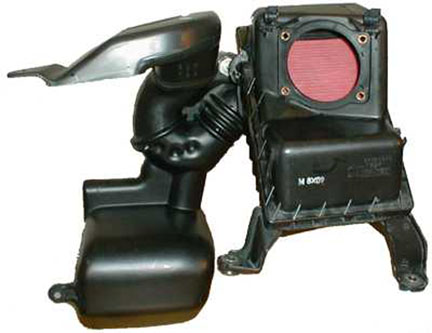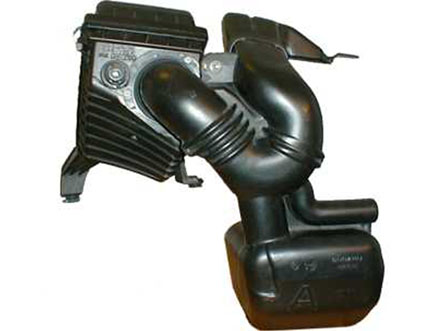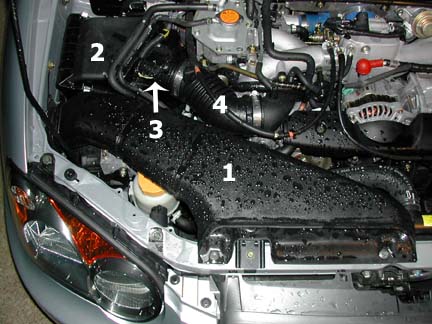Frequently Asked Questions
Turbocharger FAQ:
Intake Pipe
The primary purpose of an aftermarket intake is to increase the amount of air flow the engine receives.
HP gain is 0-15HP. These HP figures are a range as different intakes have different dyno results.
What is an aftermarket intake? Aftermarket intakes can be broken down into two types:
1. Short ram: AKA shorty or ram pod.
2. Cold air intake: AKA CAI.
What does the stock intake look like? To gain a perspective on how aftermarket intakes function, the stock intake features will be shown and discussed for further clarity.
This is the stock intake as viewed from the driver's side.
The "U" shaped assembly and the tank that connects to it on the left is commonly referred to as the snorkle, snorkus, silencer, or resonator. It is actually hidden in the fender.

This is the stock intake as viewed from the passenger's side.

This is the stock intake as viewed from above.
1. Stock "ram intake" funnel.
2. Stock air filter box.
3. MAF sensor.
4. MAF sensor piping.

What is a short ram? This is an aftermarket intake that removes the stock fenderwell snorkel components and draws air from the engine bay. To generalize, it is essentially a filter unit that replaces the stock air filter box. Some aftermarket short rams also replace some or all of the stock MAF piping with aftermarket piping.
What is a CAI? This is an aftermarket intake that removes the stock fenderwell snorkel components and replaces them with aftermarket piping. These systems, depending on the manufacturer, may or may not replace the MAF piping as well. These systems draw air from the fenderwell.
Which type of Subaru does this information apply to? This post is generally catered towards turbocharged models. Naturally aspired Subarus actually see good, solid, and safe gains from an aftermarket intake. The STi appears to accept some intakes without as many ill effects as the WRX and little data is known about other turbocharged Subaru models. The information about aftermarket filters' filtration capabilities is applicable to all vehicles though and is a point of consideration for some owners.
Is the stock WRX/STi system adequate? Yes. The majority of major Subaru tuners agree that the stock intake is adequate to power levels in the 400HP range. It also has the following advantages:
1. The standard air scoop is mounted high in the engine bay. This makes it resistant to ingress of water. The design of the fender snorkel helps to remove any water that is drawn in by this scoop.
2. Air drawn in is cool, since the air comes from the edge of the engine bay, and at speed, all air will be drawn from outside.
3. The standard system is quiet since the resonator in the fender helps filter out noise from the air flow.
4. The stock ECU is calibrated to work perfectly with the stock intake system.
Are there any downsides to aftermarket intakes? There are potential problems with some intake systems. Most manufacturers utilize less dense filtration media in their filters. This equates to increased particulate matter ingestion via the intake. This depends on the manufacturer's choice of filter media and is something to be taken into consideration. CAI can be suseptible to water ingestion. This is because through their design the filter media is quite low in the fenderwell. Extreme caution should be used when driving through standing water or other areas where water is present. The major downside of intakes are problems with the air/fuel ratio.
Which intakes do not cause problems with the air/fuel ratio? The only manufacturers of intakes that claim in writing not to cause any ill effects are:
a. TurboXS
b. APS
c. Perrin (based on my personal email correspondance with Perrin)
d. K&N Typhoon (based on testing by nhluhr and testing by AaronWRX, both NASIOC members) These tests were performed on an STi and their effect on WRX A/F ratios is untested.
e. Cobb Tuning
f. SPT
Do intakes cause problems with the air/fuel ratio? Many seem to believe that since their XXX intake does not cause a CEL or exhibit any drivability problems, then their XXX intake must be good. Though the apparent increase in power gives them peace of mind, what they don't take into account is their intake is actually causing unseen harm to their engine. This is generally due to two reasons:
1. The intake piping diameter is incorrect. This can cause a lean condition in the case of larger than stock diameter piping or a rich condition with decreased diameter piping.
2. The air flow is not laminar. The stock piping, through it's apparent unusual design, is constructed to smooth out turbulent air flow. Aftermarket systems do not take this into consideration. When turbulence occurs, the MAF sensor will suddenly see more or less air then it had previously. This will cause the ECU to respond by making the engine run leaner or richer for as long as the error from turbulence occurs.
Can the intake problems be corrected through aftermarket engine management? Yes. There are a wide variety of engine management systems that have the capability of modifying the mass air flow values to correct intake piping that is non-OEM size. Some intakes have especially troublesome turbulence problems. Since this turbulence can occur at different points in the power band, based on both engine RPM and engine load, all that can be done to make the engine run safely is to recalibrate the engine with a relatively rich overall tune to compensate.
Is there something I can do myself to free up my intake? Many owners remove their snorkel and utilize an aftermarket filter in the stock air box to free up the intake system somewhat. Instructions for this procedure can be found via this link, this link, and this link.
Which manufacturer is best? This topic is highly debated. There have been no reported consistent "bad" intakes on the market. Obviously, there may have been bad intakes sold, but not enough to report as "bad" overall.
Which intakes have the best gains? There is no irrefutable evidence that any intake has better gains than another.
Where do I buy an intake? Every Subaru/Import performance store sells intakes. For purchasing, support your local economy or the NASIOC Vendors.
How hard is it to install an intake? Allow around one hour for install time. Professional installation, depending on your area, is around $75. This is one vehicle modification that is very simple and can be successfully accomplished by even the greenest shade tree mechanic.
Do I need engine management/tuning with an intake? For most people, yes. Though there are a few that are or claim to be plug and play, tuning will make any intake shine or turn a "cheap-o unsafe" intake into a safe and power making unit.
How do I install an intake? Refer to the intake manufacturer's instructions. Below are links to some of the better known intake installation instructions:
TurboXS's Instructions (with photos)
scoobymods.com instructions (with photos)
Cobb Tuning's instructions (with photos)
Should I reset my ECU after this mod? It is never a bad idea to perform an ECU reset after a mod. The traditional route is to disconnect the negative battery terminal, press the brake pedal for a few seconds to bleed the system of charge, and reattach. Some use the more advanced Vishnu Reset.
What about just using a drop in air filter like K&N etc.? Many people will install an aftermarket air filter with two lines of reasoning:
a. longer lifespan due to end user cleaning = cost savings
b. freer flowing = more HP
While both are probably true, there are costs associated with using an aftermarket drop in air filter.
a. Comparing costs of the OEM paper filter at $10 vs an aftermarket unit at $40 mean you will have to use the aftermarket unit for 150,000 miles before you see any return on your investment based on change frequency schedules.
b. freer flowing means more contaminants work their way into your engine. Filtration study and Filtration study
c. HP gains are not well documented if at all.
The primary purpose of an aftermarket intake is to increase the amount of air flow the engine receives.
HP gain is 0-15HP. These HP figures are a range as different intakes have different dyno results.
What is an aftermarket intake? Aftermarket intakes can be broken down into two types:
1. Short ram: AKA shorty or ram pod.
2. Cold air intake: AKA CAI.
What does the stock intake look like? To gain a perspective on how aftermarket intakes function, the stock intake features will be shown and discussed for further clarity.
This is the stock intake as viewed from the driver's side.
The "U" shaped assembly and the tank that connects to it on the left is commonly referred to as the snorkle, snorkus, silencer, or resonator. It is actually hidden in the fender.

This is the stock intake as viewed from the passenger's side.

This is the stock intake as viewed from above.
1. Stock "ram intake" funnel.
2. Stock air filter box.
3. MAF sensor.
4. MAF sensor piping.

What is a short ram? This is an aftermarket intake that removes the stock fenderwell snorkel components and draws air from the engine bay. To generalize, it is essentially a filter unit that replaces the stock air filter box. Some aftermarket short rams also replace some or all of the stock MAF piping with aftermarket piping.
What is a CAI? This is an aftermarket intake that removes the stock fenderwell snorkel components and replaces them with aftermarket piping. These systems, depending on the manufacturer, may or may not replace the MAF piping as well. These systems draw air from the fenderwell.
Which type of Subaru does this information apply to? This post is generally catered towards turbocharged models. Naturally aspired Subarus actually see good, solid, and safe gains from an aftermarket intake. The STi appears to accept some intakes without as many ill effects as the WRX and little data is known about other turbocharged Subaru models. The information about aftermarket filters' filtration capabilities is applicable to all vehicles though and is a point of consideration for some owners.
Is the stock WRX/STi system adequate? Yes. The majority of major Subaru tuners agree that the stock intake is adequate to power levels in the 400HP range. It also has the following advantages:
1. The standard air scoop is mounted high in the engine bay. This makes it resistant to ingress of water. The design of the fender snorkel helps to remove any water that is drawn in by this scoop.
2. Air drawn in is cool, since the air comes from the edge of the engine bay, and at speed, all air will be drawn from outside.
3. The standard system is quiet since the resonator in the fender helps filter out noise from the air flow.
4. The stock ECU is calibrated to work perfectly with the stock intake system.
Are there any downsides to aftermarket intakes? There are potential problems with some intake systems. Most manufacturers utilize less dense filtration media in their filters. This equates to increased particulate matter ingestion via the intake. This depends on the manufacturer's choice of filter media and is something to be taken into consideration. CAI can be suseptible to water ingestion. This is because through their design the filter media is quite low in the fenderwell. Extreme caution should be used when driving through standing water or other areas where water is present. The major downside of intakes are problems with the air/fuel ratio.
Which intakes do not cause problems with the air/fuel ratio? The only manufacturers of intakes that claim in writing not to cause any ill effects are:
a. TurboXS
b. APS
c. Perrin (based on my personal email correspondance with Perrin)
d. K&N Typhoon (based on testing by nhluhr and testing by AaronWRX, both NASIOC members) These tests were performed on an STi and their effect on WRX A/F ratios is untested.
e. Cobb Tuning
f. SPT
Do intakes cause problems with the air/fuel ratio? Many seem to believe that since their XXX intake does not cause a CEL or exhibit any drivability problems, then their XXX intake must be good. Though the apparent increase in power gives them peace of mind, what they don't take into account is their intake is actually causing unseen harm to their engine. This is generally due to two reasons:
1. The intake piping diameter is incorrect. This can cause a lean condition in the case of larger than stock diameter piping or a rich condition with decreased diameter piping.
2. The air flow is not laminar. The stock piping, through it's apparent unusual design, is constructed to smooth out turbulent air flow. Aftermarket systems do not take this into consideration. When turbulence occurs, the MAF sensor will suddenly see more or less air then it had previously. This will cause the ECU to respond by making the engine run leaner or richer for as long as the error from turbulence occurs.
Can the intake problems be corrected through aftermarket engine management? Yes. There are a wide variety of engine management systems that have the capability of modifying the mass air flow values to correct intake piping that is non-OEM size. Some intakes have especially troublesome turbulence problems. Since this turbulence can occur at different points in the power band, based on both engine RPM and engine load, all that can be done to make the engine run safely is to recalibrate the engine with a relatively rich overall tune to compensate.
Is there something I can do myself to free up my intake? Many owners remove their snorkel and utilize an aftermarket filter in the stock air box to free up the intake system somewhat. Instructions for this procedure can be found via this link, this link, and this link.
Which manufacturer is best? This topic is highly debated. There have been no reported consistent "bad" intakes on the market. Obviously, there may have been bad intakes sold, but not enough to report as "bad" overall.
Which intakes have the best gains? There is no irrefutable evidence that any intake has better gains than another.
Where do I buy an intake? Every Subaru/Import performance store sells intakes. For purchasing, support your local economy or the NASIOC Vendors.
How hard is it to install an intake? Allow around one hour for install time. Professional installation, depending on your area, is around $75. This is one vehicle modification that is very simple and can be successfully accomplished by even the greenest shade tree mechanic.
Do I need engine management/tuning with an intake? For most people, yes. Though there are a few that are or claim to be plug and play, tuning will make any intake shine or turn a "cheap-o unsafe" intake into a safe and power making unit.
How do I install an intake? Refer to the intake manufacturer's instructions. Below are links to some of the better known intake installation instructions:
TurboXS's Instructions (with photos)
scoobymods.com instructions (with photos)
Cobb Tuning's instructions (with photos)
Should I reset my ECU after this mod? It is never a bad idea to perform an ECU reset after a mod. The traditional route is to disconnect the negative battery terminal, press the brake pedal for a few seconds to bleed the system of charge, and reattach. Some use the more advanced Vishnu Reset.
What about just using a drop in air filter like K&N etc.? Many people will install an aftermarket air filter with two lines of reasoning:
a. longer lifespan due to end user cleaning = cost savings
b. freer flowing = more HP
While both are probably true, there are costs associated with using an aftermarket drop in air filter.
a. Comparing costs of the OEM paper filter at $10 vs an aftermarket unit at $40 mean you will have to use the aftermarket unit for 150,000 miles before you see any return on your investment based on change frequency schedules.
b. freer flowing means more contaminants work their way into your engine. Filtration study and Filtration study
c. HP gains are not well documented if at all.
